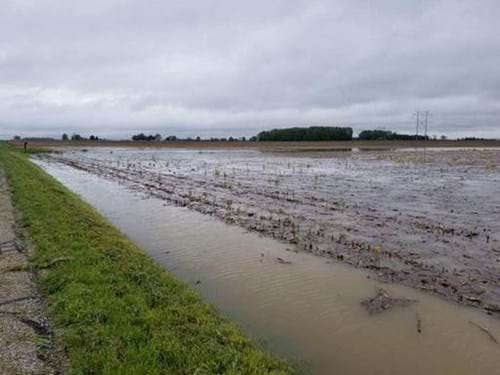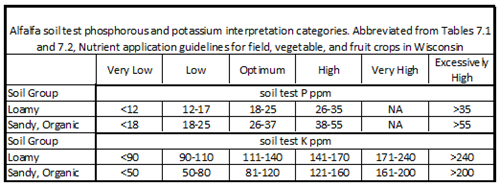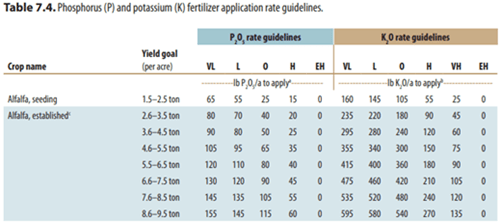Agronomy Update: Spring 2020 Weather Impact And Alfalfa Fertility 101
BY DAIRYLAND SEED AGRONOMY TEAM
Ponding, Flooding and Excess Moisture
As can be expected, weather across the upper Midwest in the Dairyland Seed marketing area can be varied. That is the case this year as it relates to precipitation. We have all been experiencing cooler than normal temps but the precipitation has varied. From this week’s agronomy conference call, the heaviest accumulations occurred more Central and East. With these heavy rains, we have severe flooding in some fields.
The concern is whether newly planted seeds and seedlings will survive and how long can they tolerate saturated soils or flooded conditions. Typically, the younger the plant, the less tolerance for saturated conditions. Seeds and seedling are living and yes “breathing” organisms in the fact they need oxygen to some degree. The key to corn survival, similar to freeze injury which some of you dealt with recently, is the growing point. If the growing point is below water, it has about 48 hours given cool temperatures. As the temperature rises, the mortality rate increases. Soybean seed and soybean seedlings are about the same -- a couple days of too much water and they start to lose germination or die. Most corn and soybeans are at these critical growth stages across the Dairyland Seed marketing area. The key is the number of hours of flooding and temperature which determines plant mortality. The critical numbers are roughly 48 hours and 77 degrees or less for both crops.
If you are in one of the flooded areas and suspect replant, refer to previous newsletters on replant information. The other suggestion is to inform your local Dairyland Seed representative to so we can begin to stage replant seed if needed.

Replant 2020??
Last week we discussed some strategies for determining when to or not to replant – see last week’s Agronomy Update. Those strategies are still valid, but the challenges have perhaps increased since over the past ten days we have:
- Experienced temperatures as low as the low 20s
- Seen at least two additional mornings of heavy frost – temps dipping down to the high 20s
- Had between 3 and 6 inches of rain over much of the Dairyland territory over a four-day period.
These weather events occurred while and just after we planted a majority of the corn and soybean crop in much (especially the eastern half) of the Dairyland Seed footprint. Oh, my!!
So, what do we say about replant now?
- Be patient. We need several days to dry out and then investigate the viability of seeds and seedling. Any chilling injury effects should be obvious as soon as we dry out enough to examine seeds and seedlings. Seed and seedling suffocation due to flooding will require at least four to five days after the flooding event to become clear.
- Generally, it’s best not to make replant decisions before a day or two prior to when soil conditions are satisfactory for replant. Even then, it may not be prudent to decide to replant if seeds and seedlings are still viable but not yet emerged. A few more days may be necessary to determine emergence and final stand, and thus make the best replant decision.
- Time is on our side, although the window can close quickly. We are only two-thirds of the way through May. We have a good window yet to replant if necessary and still expect good to excellent yields.
Do be in touch with the agronomy team and with your seed dealer/DSM to discuss replant questions, timings, and seed availability if needed.
Alfalfa Fertility 101
Profitable alfalfa crops are driven by yield, requiring a strong fertility program. Soil-test-based programs are most effective, but consider that one dry ton of alfalfa removes about 14lbs of P2O5 and 58lbs of K2O from the soil. Depending on your soil test levels, we recommend a fertilizer application after first cutting to help carry through the season, then again after third cutting to ensure health going into winter.
First, be sure that your soil pH is appropriate, 6.8 being the target. Plan ahead since lime application take months or years to do their job. Lime products are not created equally, so have a discussion with your supplier. Depending on the product, lime applications should cover Mg and Ca needs too.
Second, address P and K. Rate recommendations vary slightly by region or state, but will lead to similar results. We will only include WI in the interest of newsletter space. Identify your soil test categories in Tables 7.1 and 7.2, then find your annual fertilizer needs in Table 7.4. Split apply after first and third cuttings. The main point here is that annual maintenance level rates of P2O5 and K2O could be over 100lbs and 500lbs, respectively!
Lastly, most fields will benefit from a 50lb rate of AMS and 10lb rate of Boron.


Source: Nutrient Application Guidelines for Field, Vegetable and Fruit Crops in Wisconsin (A2809). 2012. Laboski and Peters. UW Extension. https://cdn.shopify.com/s/files/1/0145/8808/4272/files/A2809.pdf
Corteva Technology Use Agreements
All growers with orders for any Corteva Agriscience brand seed product, regardless of crop or trait (including non-GM products) need to have a signed Corteva Technology Use Agreement in place by September 1. Growers should sign the Corteva Technology Use Agreement electronically at www.agcelerate.com. Signing electronically is preferable, however, paper copies are available at www.traitstewardship.com.
 |
 |
 |
 |
 |
| Brian Weller Western Region 507.456.3034 |
Dan Ritter Central Region 219.863.0583 |
Branden Furseth Northern Region 608.513.4265 |
Rod King Eastern Region 574.596.6721 |
Terry Jones Eastern Region 419.630.3115 |
